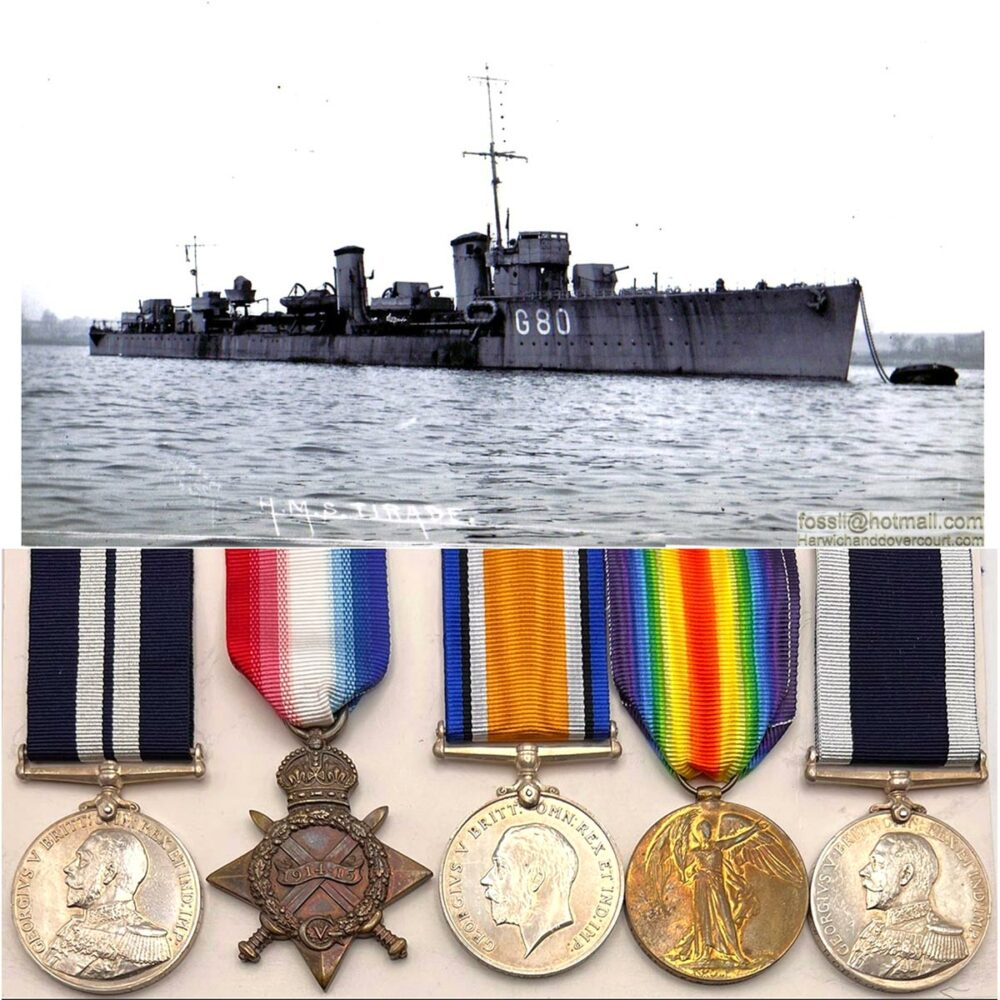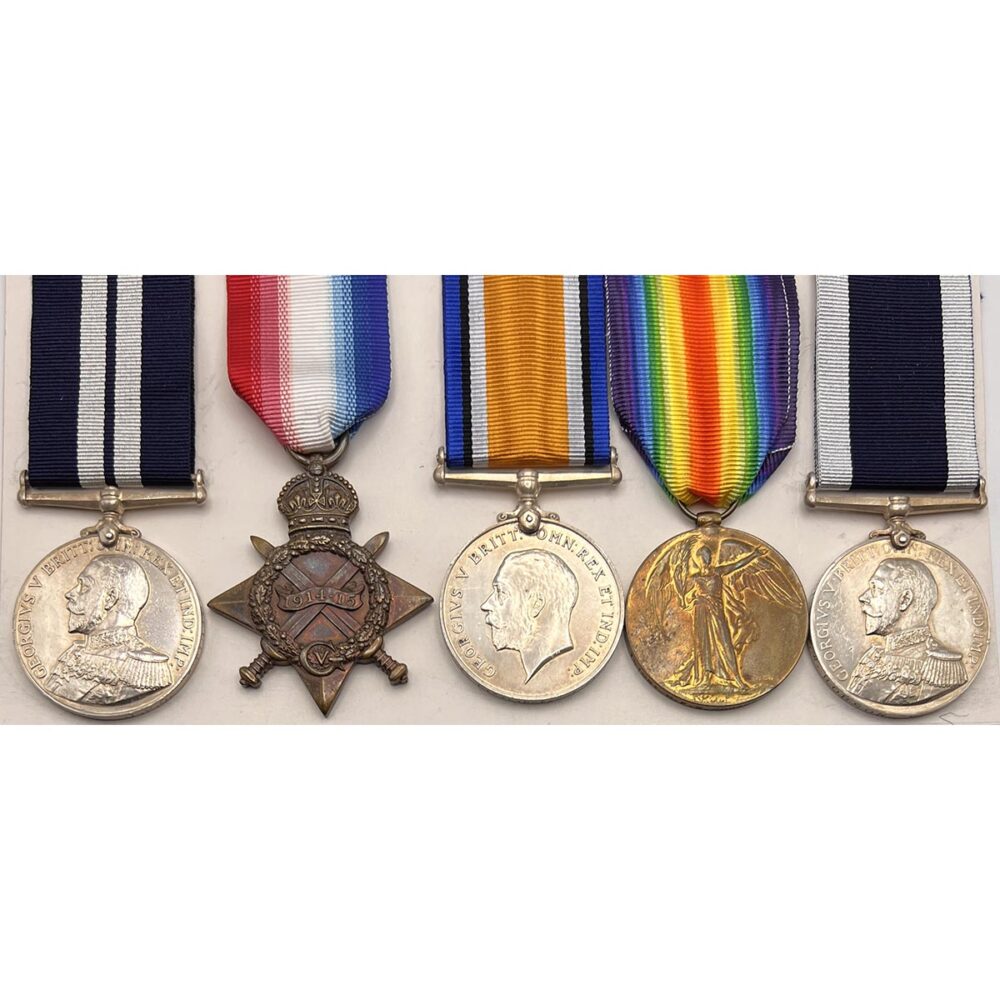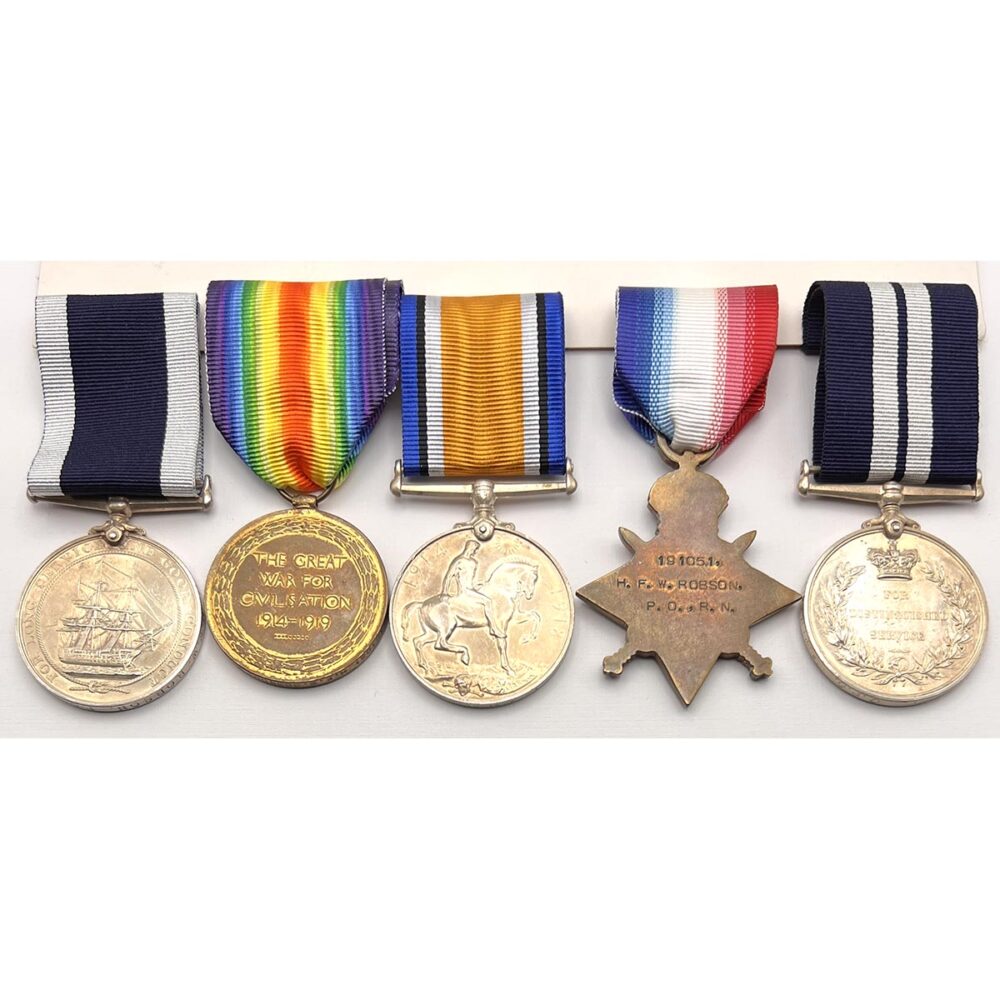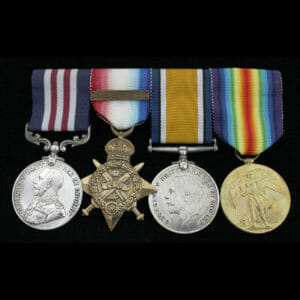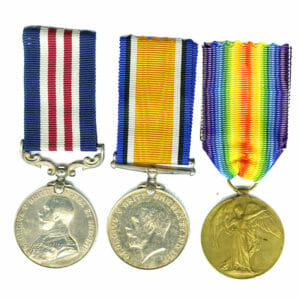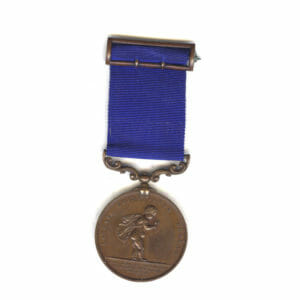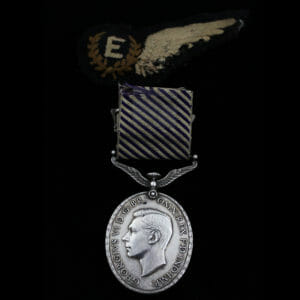Description
Distinguished Service Medal, 1914-15 Trio, RNLSGC, Chief Petty Officer H.F.W. Robson, Royal Navy, awarded DSM for Destroyer Service on HMS Tirade, fought the Bolsheviks during 1919.
Robson, a 26 year veteran of the Royal Navy, son of a Commissioned Boatman of the Coast Guard, in the Navy since 15 leaving the Greenwich Hospital School, was very experience and held his Naval Long Service Medal since 1914, he saw much service being stationed on Destroyers in the war as Chief Petty Officer.
He was onboard the R-Class Destroyer HMS Tirade when she sank the Submarine UC-55 in September 1917, and the following month when she would unfortunately claim the sinking of the British M-Class Destroyer Marmion.
The troublesome UC-55 had 9 ships sunk with 3 damaged when Tirade sank her off the coast of the Shetland Islands, having been a particular thorn in the side to the nearby Norwegian Ships in the region.
After the war had ended he was sent on a new on, when he spent a year floating around Russia from Dec 1919 to Dec 1920, on board HMS Vivacious during which time she was deployed in the Baltic Sea and was in action against Russian Warships, manned by the Bolshevik Forces as part of the Russian Civil War.
DSM Officially impressed: “191051 H.F.W. Robson, C.P.O. ‘Tirade’ 1918”
1915 Star impressed: “191051 H.F.W. Robson P.O. R.N.”
Pair impressed: “191051 H.F.W. Robson C.P.O. R.N.”
LSGC impressed: “191051 H.F.W. Robson P.O. H.M.S. Actaeon” the “AE” interestingly impressed as Æ, the Latin inspiration for the ship.
DSM awarded, The London Gazette, 10th December 1918, “Honours for services in Grand Fleet Destroyers between 1st January and 30th June 1918.”
Period Postcard of HMS Tirade not included but it is from harwichanddovercourt.com who provide a good summary and a great picture of the ship, Click here to visit Harwichanddovercourt.com page about Ships of the Harwich Force including HMS Tirade
Chief Petty Officer Robson, was born into the Navy, born in 1881 by the sea side of the East of England in Sizewell, Suffolk.
Son of Henry Frederick Robson HM Coast Guard (1853-1934) and Lavinia Robson
His father, Commisioned Boatman Henry Frederick Robson (B 1853) H.M. Coast Guard was a particularly long serving seamen who transferred to the Coast Guard and held a Naval Long Service Medal of his own. (awarded July 1881)
He grew up around different coast guard stations where his father was currently stationed at.
A Young CPO Robson, destined for the navy received his education at the Royal Greenwich Hospital School until the age of 15, when he first joined the Royal Navy, the beginning of a 26 years career in the Royal Navy, rivalling that of his father before him. His father had similarly joined up as a Teenage Boy 1st Class Circa 1870.
“DESTROYED BY AN ESCORT
The UC55 was destroyed as an escort approached Lerwick on 29th September 1917. An Affidavit by Fleet Lieutenant-Commander H.D. Crawford Stanistreet, DSO, in command of HMS Tirade said that the Tirade was one of an escort of the convoy, and turned to ram the submarine, which was discovered on her quarter.
HMS Sylvia in command of Lt Peter Shaw, since deceased, also opened fire. The Submarine was struck repeatedly. 1 Shot hit the base of the conning tower, which disabled the submarine. Before H.M. Ships reached her to ram her she sank, her bows rising vertically as she went down. There were 19 survivors of a crew of 29.
Centarbury Gazeete, 5th September 1896, recalls the father and son and a rather traumatic experience of finding a dead man.
Henry Frederick Robson, a Coastguardman, deposed that he resided at Seasalter, Coastguard Station. On the previous night at about 9:15, he rode home from Whitstable in a Van belonging to Mr Wm Overy, Fruiterer of Faversham.
There were also in the Van Mr Overy, and the Witnesses Son, Henry Robson, and a man named Edward Downey and his wife. When a few yards down Joy Lane thye came upon a van in the ditch. They got down, took one of the lamps, and called out for the man, but there was no answer. They then looked around and found deceased underneath the horse in the ditch. He was quite dead. As soon as deceased was found, witness and the others tried to extricate him, but failed, and witness went for assistance. The horse was alive and sturggling violently on the top of the deceased.
Born 21st May 1881 in Blything, Suffolk.
In 1939 he lived in Gilingham with his wife and children, working in a Motor Garage.
He died in Chatham, Kent During 1949.
He first signed up for the navy at 15, straight from the Greenwich Hospital School.
Boy 2nd Class on 10th October 1896, HMS St Vincent.
Boy 1st Class, 20th May 1893, HMS ST Vincent.
Ordinary Seaman, HMS Renown, 21st May 1899.
Leading Seaman, 30th October 1902, HMS Pembroke.
Petty Officer 1st Class, 10th August 1904.
Acting Chief Petty Offficer, 1st June 1915, HMS Tyne.
Earned his Royal Naval LS&GC On board HMS Actaeon on 2nd June 1914, whilst serving on board between 19th May 1914 until 26th March 1915 as a Petty Officer.
His Wartime Ship Postings:
HMS Meteor, 17th October 1916 – 10th April 1917, during which time went from Acting CPO to full Chief Petty Officer. During this time HMS Meteor was mined on 13th March 1917 and laid up for repairs, leading to him joining HMS Tirade.
Joined HMS Tirade as CPO from 23rd June 1917 until 11th March 1919. SANK UC 55
HMS Splendid, from 12th March 1919 – 7th December 1919
HMS Vivacious, 8th December 1919 to 15th December 1920. RUSSIAN CIVIL WAR.
Notably during his entire service it appears each and every assessment of his character was seen as “VG” or Very Good, with additional Super or Exemplary.
After returning home from Russia, he was disharged to his Shore Pension on 8th July 1921, joining the Royal Fleet Reserve.
Being Discharged from the RFR on 10th February 1922.
Chatham News, 17th December 1971, the anniversary of his death:
“ROBSON – In loving memory of Henry Frederick Robson who died on 17th December 1949, from his loving family.”
NOTES ON HIS SHIPS
HMS METEOR, 17th OCTOBER 1916 – 10th APRIL 1917
In October 1916 she was part of the Tenth Flotilla at Harwich, which now contained all thirteen of the original M class ships, the flotilla leader HMS Nimrod and the ex Greek destroyer HMS Melpomene.
In January 1917 she was one of ten destroyers from the Tenth Flotilla that were still at Harwich, while the rest had been detached to Dover.
On 22 January 1917 the Germans sent the 6th Flotilla of torpedo boats from Germany to reinforce the Flanders command. The British intercepted radio communications and correctly guessed that the force was heading for Zeebrugge. The British dispatched Tyrwhitt’s Harwich Force to attempt to intercept the Germans. He had six light cruisers (split into two division), one flotilla leader and ten destroyers from his own command and another flotilla leader and six destroyers from Dover in support. Tyrwhitt placed two destroyer divisions, under the Nimrod and Simoom to the south, seven destroyers (including the Meteor) further north to patrol off the Mass and his cruisers furthest from the coast. Early on 23 January the Germans briefly clashed with the two cruiser divisions, and their formation partly broken, although most reached their destination intact. The Meteor attempted to move towards the sound of the guns, but didn’t get into action. However she did come close to a German U-boat, as a torpedo that had been fired at the cruiser Grenville passed directly under her.
On 10 February 1917 the Matchless spotted a U-boat while escorting a west bound convoy from the Netherlands. After dropping one depth charge she returned to the convoy and ordered the Meteor to take over the hunt. At 11.38 the Meteor opened fire on a suspected U-boat, driving it down. She continued to hunt the U-boat for some time, but it escaped undamaged (possibly UC-4, on her way to lay mines of Lowestoft).
By March 1917 the Meteor had been officially transferred to the Sixth Destroyer Flotilla at Dover, and by July she had been joined by her entire class.
On 13 March 1917 the Meteor struck a barrage mine and suffered damaged.
This information: Rickard, J (4 January 2023), HMS Meteor (1914) , http://www.historyofwar.org/articles/weapons_HMS_Meteor_1914.html
HMS VIVACIOUS, FIGHTING THE BOLSHEVIKS RUSSIAN CIVIL WAR
Some of the interesting events in Russia are recounted in the excellent Book by Damien Wright 2017: Churchill's Secret War With Lenin, British and Commonwealth Military Intervention in the Russian Civil War, 1918–20.
“On June 2nd, Cowan sent the Destroyed HMS Vivacious (Commander CL Bate RN) and HMS Voyager (Lt Cdr CG Stuart DSC RN) to patrol north of the minefield as a precaution, should the Bolsheivks attempt to mine Biorko harbour before the bulk of the fleet arrived.
In transit to the Finnish Coast these two British Destroyers encountered Azard and Gavril still safely behind the Minefield. The Destroyers engaged a few shots at long range without effect. The following day E27 made another failed attack on a Bolshevik Ship, both torpedoes malfunctioned and exploded short of their intended target.”
“On June 7th, Cowan established an observation station east of Biorko to guard against any surprise moves from the Bolshevik Fleet. the station required a rotation of 3 destroyers at Anchor facing seward at all time at 5 minutes notice to move.
Cowan’s preparations were all for naught when on the night of 9th June, the Azard and Gavril left Kronstadt without being observed and then attacked HM Ships Versatile, Vivacious and Walrus who were at anchor.
The British Destroyers returned fire whilst Cowan despatched ships from Biorko in support. After firing 80 rounds the Soviet Ships returned to cover behind the minefield without either side having a scored a hit. It was the most aggressive mode made by the Bolsheviks to date and could have ended much worse for the British.”
